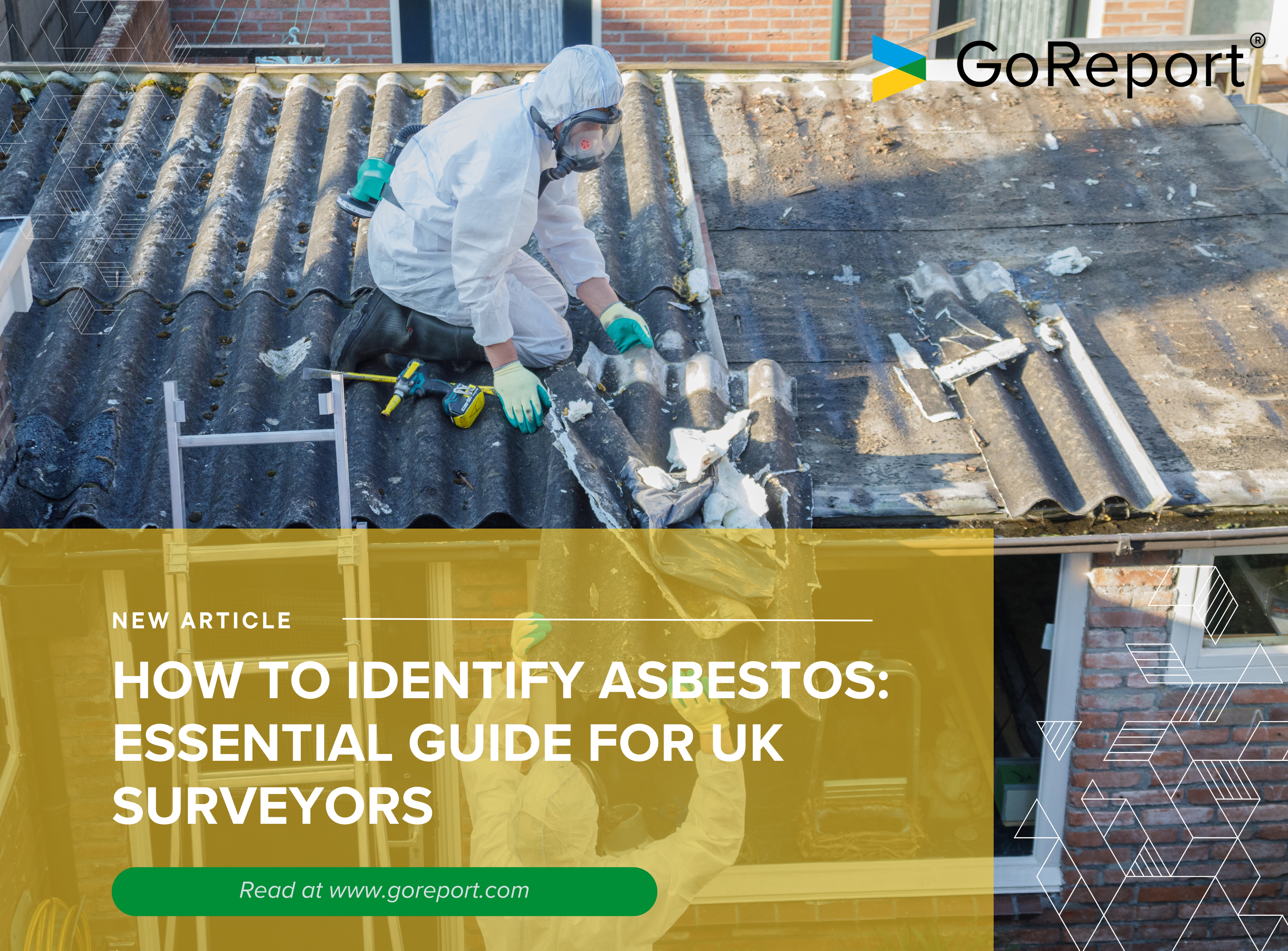How to Identify Asbestos: Essential Guide for UK Surveyors

Understanding how to identify asbestos and manage it effectively is not only good practice for surveyors – it’s a legal necessity. Asbestos, once popular because of its durability, fire resistance, and insulation properties, is now recognised as a hazardous material with severe health implications. For professionals in surveying, construction, and property management, asbestos awareness isn’t optional; it’s essential for compliance with UK regulations and safeguarding health.
This comprehensive guide, tailored specifically for surveyors, will cover everything from recognising asbestos-containing materials to implementing proper management strategies in line with legal obligations. Whether you’re conducting routine inspections, preparing for a refurbishment project, or managing existing asbestos risks, this guide to asbestos awareness and management ensures you’re fully prepared.
Contents:
- Asbestos Awareness: What Is Asbestos and Why Is It a Risk?
- Asbestos Regulations: What Surveyors Need to Know
- Where Is Asbestos Commonly Found?
- How to Identify Asbestos
- The Three Main Types of Asbestos
- Types of Asbestos Surveys
- How to Report Asbestos Findings
- Best Practices for Surveyors
- Asbestos Management Responsibilities and Planning
- Frequently Asked Questions (FAQs)
What Is Asbestos and Why Is It a Risk?
What Is Asbestos?
Asbestos refers to a group of naturally occurring silicate minerals known for their durability, heat resistance, and insulating properties. It was widely used in the UK’s construction industry, particularly in the mid-20th century, finding its way into roofing materials, pipe insulation, cement sheets, ceiling tiles, and floor coverings.
However, all forms of asbestos were officially banned in the UK in 1999 due to overwhelming evidence of its health risks. Buildings constructed before this ban often still contain ACMs, making the identification and management of asbestos an ongoing concern for surveyors.
Why Is Asbestos Hazardous?
The danger of asbestos lies in its microscopic fibres. When ACMs are disturbed – typically through renovation, drilling, or demolition – these fibres can become airborne. Inhaling asbestos fibres can lead to severe and often fatal diseases, including:
- Mesothelioma: An aggressive cancer primarily affecting the lining of the lungs or abdomen, almost exclusively caused by asbestos exposure.
- Asbestosis: A chronic lung disease resulting from prolonged asbestos exposure, leading to scarring and impaired lung function.
- Lung Cancer: Strongly associated with asbestos exposure, particularly among workers in construction, shipbuilding, or demolition.
Shockingly, the latency period of asbestos-related diseases can be 20 – 40 years, meaning symptoms may not appear until decades after exposure. This reflects the importance of preventative action through proper surveying and management, as well as safety measures.
Asbestos Regulations: What Surveyors Need to Know
Surveyors in the UK must comply with strict legal requirements regarding asbestos management. The principal regulation governing asbestos in the UK is the Control of Asbestos Regulations 2012, which outlines the responsibilities of surveyors, duty holders, and employers.
If these rules aren’t followed, there can be serious consequences. The Health and Safety Executive (HSE) enforces these regulations and can issue improvement notices, prohibition notices, or even take legal action. In more serious cases, breaking the law can lead to hefty fines or even prison sentences of up to two years.
There is also the possibility of being sued if someone is exposed to asbestos because proper precautions were not taken. On top of that, not following the rules can damage a surveyor’s reputation and could result in losing professional memberships, such as with the Royal Institution of Chartered Surveyors (RICS).
Key duties include:
- Identifying and assessing the risk of asbestos in buildings.
- Recording the location, condition, and type of ACMs.
- Developing and implementing an asbestos management plan.
- Ensuring that anyone who is likely to disturb asbestos receives adequate information and training.
These regulations are enforced by the Health and Safety Executive, which also provides surveyors and property managers with comprehensive asbestos management guidance.
Where Is Asbestos Commonly Found?
Knowing where asbestos is likely to be found is essential, particularly in buildings built before the year 2000. Common locations include:
- Ceiling tiles and textured coatings: Often found in offices, schools, and public buildings.
- Pipe insulation and boiler lagging: Frequently seen around older heating systems.
- Vinyl floor tiles and adhesives: Asbestos was often mixed into flooring materials.
- Cement sheets and panels: Used in garages, cladding, and industrial units.
- Roofing felt and bitumen products: Frequently used in flat roofing systems.
- Artex ceiling coatings: A popular decorative finish applied before 2000.
Surveyors must conduct thorough inspections, particularly before any refurbishment, demolition, or invasive maintenance work.
How to Identify Asbestos
What Does Asbestos Look Like?
Identifying asbestos just by looking at it is a challenge, but surveyors should be aware of these common characteristics:
- Fibrous texture: Asbestos insulation can appear fluffy or fibrous.
- Cement-like materials: Asbestos cement may resemble standard concrete but contains embedded fibres.
- Textured finishes: Older ceiling coatings, such as Artex, may contain asbestos if applied before the 2000 ban.
- Dusty or crumbly materials: Particularly on pipe lagging and insulation boards.
Can You Identify Asbestos Without Testing?
No. Visual inspection alone is not enough to confirm the presence of asbestos. The only way to verify asbestos is through analysis of material samples by a UKAS-accredited laboratory. When in doubt, surveyors should always treat materials as potentially containing asbestos until confirmed otherwise.
The Three Main Types of Asbestos Found in the UK
Surveyors need to be familiar with the three most common forms of asbestos:
- Chrysotile (White Asbestos) – The most frequently used form, often found in roofing sheets, insulation, and vinyl flooring.
- Amosite (Brown Asbestos) – Commonly used in insulation boards, cement sheets, and ceiling tiles.
- Crocidolite (Blue Asbestos) – Known as the most dangerous type of asbestos, commonly found in sprayed coatings and pipe insulation due to its high friability and potential for airborne release.
Surveyors should also be aware of rarer forms such as tremolite, actinolite, and anthophyllite, which might be present in imported materials. However, they aren’t as common in the UK and Ireland.
Types of Asbestos Surveys
When it comes to asbestos surveys, choosing the right type is essential for adhering to UK laws and keeping everyone safe in the building. According to the Control of Asbestos Regulations 2012, duty holders are legally required to carry out surveys to find, manage, or remove any asbestos-containing materials that might be present.
For surveyors, it’s important to understand the different types of surveys and when to use them. This ensures you’re giving accurate assessments and helping clients stay fully compliant with the law.
1. Management Survey
This type of survey is usually carried out in buildings that are still being used and occupied. The main goal is to find and assess any asbestos-containing materials that could be disturbed during everyday activities, routine maintenance, or minor repairs. It’s a non-intrusive survey, so there’s minimal disruption during the inspection.
That said, surveyors still need to check all accessible areas thoroughly – this means looking behind ceiling tiles, inside ducting spaces, and any other hidden spots where asbestos might be lurking. The information gathered helps duty holders create an asbestos register and a solid management plan to ensure that any ACMs found stay undisturbed and are checked regularly.
2. Refurbishment and Demolition Survey
When a building is set for major refurbishment or demolition, a more in-depth and intrusive survey is needed. The goal here is to track down every bit of asbestos-containing material (ACM) in the property – whether it’s easy to spot or hidden out of sight. This often means using destructive methods like drilling, cutting through walls, or taking apart fixtures to access hard-to-reach areas.
This survey ensures that no ACMs are accidentally disturbed during construction or demolition, protecting workers from potential exposure. It’s essential to complete this type of survey before any structural work begins. If any asbestos is found, it must be either properly managed or safely removed by licensed asbestos professionals.
3. Reinspection Survey
When ACMs have been identified in a previous survey and the solution is to monitor rather than remove them, you must track their condition over time. A reinspection survey is typically carried out annually to check whether the asbestos has deteriorated or been damaged, which could increase the risk of fibre release.
The frequency of these checks depends on factors like the material’s current condition, how likely it is to be disturbed, and how the space is used. Any changes in the state of the ACMs need to be recorded, and the asbestos management plan should be updated to reflect those changes.
How to Report Asbestos Findings
Accurate reporting is essential for effective asbestos management, and digital solutions such as GoReport make the process more efficient and reliable. For surveyors, creating clear, detailed, and compliant reports not only ensures regulatory compliance but also provides clients with actionable information for managing asbestos safely.
1. Data Collection and Entry
During the survey, data should be gathered systematically, including details such as the location of suspected ACMs, their condition, and the likelihood of disturbance. Using GoReport, surveyors can input findings directly into a digital platform, reducing paperwork and minimising the risk of data loss. The platform’s mobile functionality allows surveyors to capture photographs, voice notes, and sketches on-site, creating a comprehensive record of the inspection.
2. Generating a Detailed Report
Once the data has been collected, GoReport’s customisable templates help surveyors generate professional reports that comply with UK asbestos regulations. Each report should include:
- A detailed asbestos register outlining the location, type, and condition of identified ACMs.
- Recommendations for action, such as removal, encapsulation, or ongoing monitoring.
- A clear risk assessment rating based on the likelihood of disturbance and the material’s condition.
3. Sharing and Updating Reports
After completing the report, surveyors can share it securely with clients or duty holders via the GoReport platform. The system allows for easy updates following reinspections or changes in the condition of ACMs, ensuring that the asbestos management plan remains current. This streamlined reporting process saves time and reduces administrative tasks for surveyors while providing clients with clear, actionable information.
With GoReport, surveyors can ensure their reports are accurate, timely, and fully compliant with the latest UK regulations.
Best Practices for Surveyors
Sticking to the right procedures keeps you compliant with UK regulations, reduces health risks, and helps maintain high professional standards. Here are some straightforward tips to help surveyors stay on top of their game:
- Keep Up with the Latest Rules – Asbestos laws and guidelines can change, so it’s important to stay in the loop. Regularly check updates from the Health and Safety Executive and other relevant bodies to ensure you’re always working by the book.
- Put Safety First – Safety should always be your top priority. Wear the right personal protective equipment (PPE) when inspecting or sampling potential ACMs, and follow strict safety protocols to minimise exposure risks for yourself and others.
- Go Digital for Reporting – Save time and improve accuracy by using digital tools like GoReport. They make it easier to collect data on-site and produce clear, compliant reports – no paperwork hassle, just efficient reporting.
- Stay on Top of Regular Checks – Regularly recheck known ACMs to monitor their condition and ensure they’re not becoming a hidden risk.
- Educate Your Clients – Many clients aren’t fully aware of their legal responsibilities when it comes to asbestos. Take the time to explain their obligations and help them develop a solid asbestos management plan.
By following these simple steps, surveyors can help ensure asbestos is managed safely and legally, protecting not just workers and occupants but also their own professional reputation.
Asbestos Management Responsibilities and Planning
Under the Control of Asbestos Regulations 2012, the responsibility for managing asbestos in non-domestic buildings typically falls on the duty holder, which is usually the property owner, landlord, or employer. Their main role is to ensure that any asbestos-containing materials are identified, regularly monitored, and managed safely to prevent exposure.
An important part of this responsibility is developing an asbestos management plan. This legally required document outlines how asbestos risks will be handled, including regular inspections, maintaining an up-to-date asbestos register, and ensuring all relevant staff or contractors are informed about potential risks.
In shared spaces, like multi-tenant buildings, these responsibilities may be split between landlords and tenants, depending on lease agreements. Clear communication is vital to ensure everyone understands their role in managing asbestos effectively.
While surveyors aren’t responsible for managing asbestos directly, they play a critical role in helping duty holders stay compliant. By identifying ACMs and providing accurate reports, surveyors help create safer environments for building occupants and ensure legal obligations are met.
Understanding how to identify asbestos, alongside proper management strategies, is vital for UK surveyors. With strict regulations in place and the potential for serious health consequences, asbestos awareness and compliance are not just legal obligations—they are essential for the safety of all building occupants.
By following the latest HSE guidance, using digital tools like GoReport, and maintaining up-to-date training, surveyors can ensure effective asbestos management and contribute to safer working environments across the UK. Give it a try by booking a free trial today.
Frequently Asked Questions (FAQs)
1. What does asbestos look like?
Asbestos can appear fibrous, cement-like, or as a dusty coating on pipes or ceilings, but laboratory testing is needed for confirmation.
2. Can I test for asbestos myself?
No. Only trained professionals should handle and test suspected ACMs due to the health risks involved.
3. What happens if I disturb asbestos?
Disturbing asbestos releases dangerous fibres. Stop work immediately and contact a professional for advice.
4. Is asbestos still legal in the UK?
No. The use of asbestos has been banned in the UK since 1999, but it remains present in older buildings.
5. How often should buildings be inspected for asbestos?
Reinspection should be conducted regularly, typically every 6 to 12 months, depending on the condition of the ACMs.
6. Who is responsible for asbestos management in rented properties?
The duty holder, often the landlord or property manager, is responsible for ensuring asbestos compliance.





